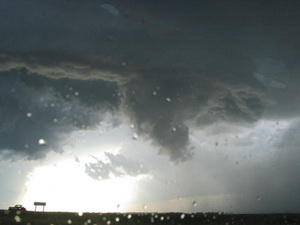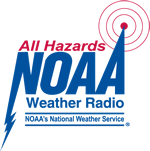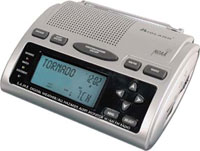
No matter whether it is a blizzard in the winter or tornadoes and hail in the summer, it is important that everyone knows where to turn for information about developing weather conditions. Keeping an eye on the sky is fine but oftentimes there is dangerous weather brewing that you may not see.
How dangerous is the weather? Consider this: In 2008, 566 people across the United States were killed by weather-related causes and 2,899 were injured – and that was a below average year. Of those, 12 were Coloradoans that were killed with 100 Coloradoans injured. Over $29 billion was paid out in property and crop losses across the nation, $166 million in Colorado alone.
The danger is real and with the severe weather we have seen recently, residents are wondering how best to keep themselves and their families safe. Tuning in the TV or radio or checking your favorite weather website is one way but what if you aren’t near your computer or don’t have your TV on? What if severe weather strikes in the middle of the night?
 It is important to note that there is only one official source for weather related alerts and warnings – the National Weather Service (NWS). All watches, warnings and alerts you see and hear about originate with the NWS and by far the best way to be proactively warned of severe weather is what is commonly referred to as a “weather radio.”
It is important to note that there is only one official source for weather related alerts and warnings – the National Weather Service (NWS). All watches, warnings and alerts you see and hear about originate with the NWS and by far the best way to be proactively warned of severe weather is what is commonly referred to as a “weather radio.”
- What do weather radio broadcasts sound like? You can listen to the broadcast live here.
NOAA Weather Radio All Hazards (NWR) is a nationwide network of radio stations broadcasting continuous weather information directly from the nearest National Weather Service office. NWR broadcasts official Weather Service warnings, watches, forecasts and other hazard information 24 hours a day, 7 days a week. When a weather watch or warning is issued, it is immediately broadcast on NWR. The system is also used to broadcast information about other civil and weather hazard information like earthquakes, avalanches, chemical spills, terrorist attacks and even AMBER alerts.
- More information: NOAA Weather Radio All Hazards (NWR) website
- More information: Specific Area Message Encoding (SAME)

It is highly recommended that any weather radio purchased include the SAME feature – Specific Area Message Encoding. Using the SAME feature, users can program a code into the radio for the area in which they live and the radio can then be set to automatically turn on and sound an alert when a weather watch or warning is issued for their area. Users of weather radios with SAME coding can be assured they will be immediately notified in an emergency.
Price and features of weather radios can vary but a good one with the SAME feature can be found for about $30.00. More expensive models may add clock, AM/FM radio and even weather forecasts retrieved from the Internet. There are portable handheld models as well that you can take with you wherever you go.
Finding a weather radio locally may be difficult as there aren’t many stores that carry them. Some Denver area King Soopers and Radio Shack stores have had them so you may call your local store to check. Alternatively, there are many good, trustworthy sites online where they can be purchased including Amazon.com, New Egg and Ambient Weather.
Weather radios provide essential information when severe weather is ready to strike. With a small investment, these units are an essential tool to protecting you and your family.
Do you have questions about weather radios? Post them in the comments section below and ThorntonWeather.com will answer them.

I recently purchased the Midland WR-100. It does have the SAME feature. My problem is that I can only receive on channel in my area. This channel is mainly focused to the more southern area of my Stat. The station, which represents my area does not reach this far west. I have projremed the radio to receive two counties. My question is: Do all stations provide the same alerts and the radio smartly detects only those which I have programed to receive. Or, is each station focused only on certain areas/counties?
Fred,
All great questions!
You want to pick the frequency / channel that originates from the National Weather Service office that covers the area in which you live. Here is Colorado there are three such offices – the Denver office covers NE Colorado, Pueblo covers most of southern CO and the Grand Junction one covers the western slope.
If you go to http://www.weather.gov and click on the national map for where you live, the map will then take you to the appropriate local office’s website. Then, listen on your radio to the broadcast – they will periodically announce where the broadcast is originating from. If it is the office you found on the Internet, then you are listening to the right frequency.
As long as you are listening to the proper office’s broadcast, you should be good to go.
Regarding your reception problem… This is not uncommon as the NWS radio transmitters cover large areas of land so it is of course hard to cover every area 100%. Even here in the north Denver area we resorted to setting up an external antenna to improve reception. In our case, we bought what is basically a CB antenna, put it outside on the fence and ran cable to the radio inside.
The WR-100, and many other weather radios, do have an antenna jack on the back. Using that, you have a couple of options. Radio Shack sells antennas that work well to improve reception and they would have the connectors you need to hook it up. Also, the frequencies the weather radio uses are actually between TV channel’s six and seven. TV antennas can be hooked up to these connections and will sometimes work to improve reception.
BTW, the Denver office has some good information on their website here: http://www.crh.noaa.gov/bou/?n=nwrnoaa
I hope all that makes sense – if not, please don’t hesitate to ask any other questions.
Thanks for the detailed response. You are performing a valuable service.